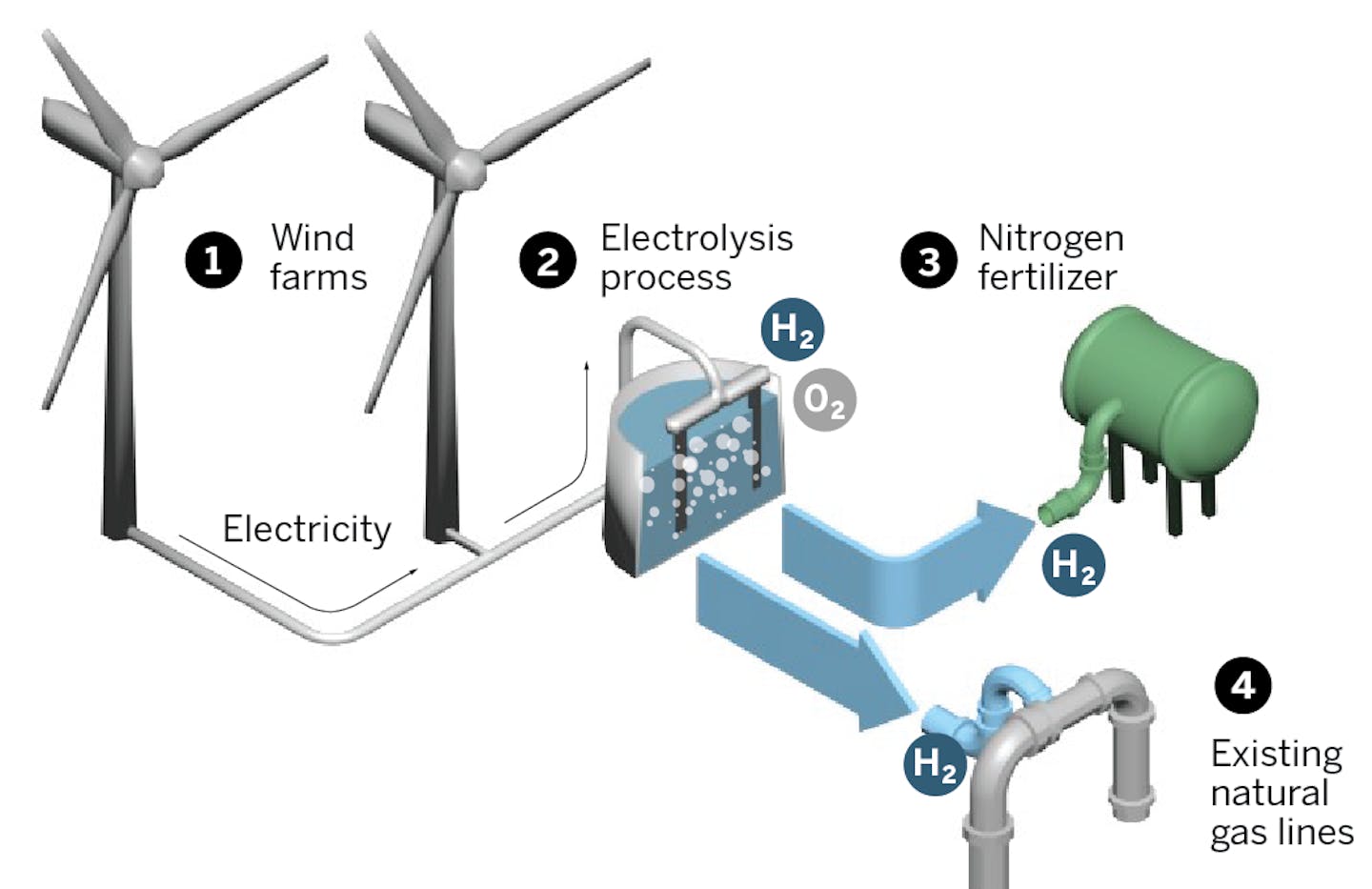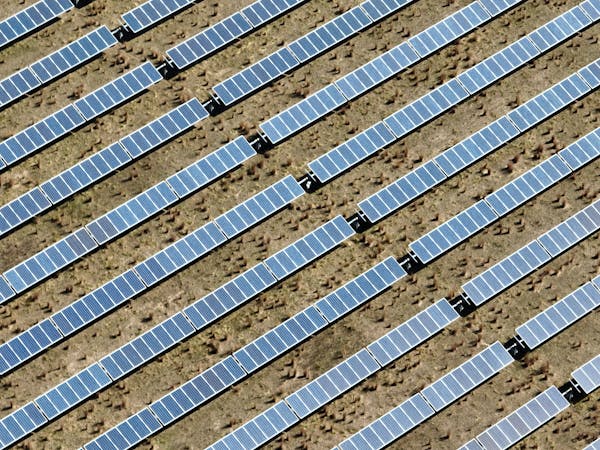The allure of "clean" hydrogen as a climate change remedy is so potent that Congress ponied up $8 billion for it.
Xcel Energy and the state of Minnesota want a chunk of that money. They are teaming up with North Dakota and other partners in the proposed "Heartland H2 Hub," which would turn the two states into a hive of hydrogen production.
The U.S. Department of Energy this year is expected to name up to 10 clean "hydrogen hubs," bestowing up to $1.25 billion on each project.
"What this is about is creating a new hydrogen economy," said Brian Ross, vice president of renewable energy at the Minneapolis-based Great Plains Institute, a nonprofit research group. "The hubs would effectively jump-start the [clean hydrogen] market."
Clean hydrogen could be a tool to abate climate change, along with renewable power. Unlike natural gas, hydrogen does not emit carbon dioxide when burned. It is seen as critical to decarbonize parts of the economy at a time when companies and states such as Minnesota have set zero-carbon goals.
Creating energy with hydrogen, though, is in its infancy with many barriers to overcome before it can be a reliable part of the clean energy equation. There are two main varieties — and both are included in the North Dakota-Minnesota proposal.
"Green" hydrogen is manufactured from renewable energy in an expensive, electricity-intensive process. Xcel would harness wind power to make hydrogen for a novel fertilizer factory in Morris, Minn. — as well as for fuel in its own power plants and heating systems.
CLEAN HYDROGEN FROM RENEWABLES


The process
"Blue" hydrogen, a bedrock of North Dakota's Heartland hub plans, is made from natural gas, the feedstock of current hydrogen production. However, the blue process captures carbon dioxide emissions from gas and stores them underground. It's also an expensive process and one that's often panned by environmental groups.
The hydrogen hub initiative is one of the largest programs ever administered by the Energy Department.
"It is an enormous amount of money," Ross said. "But it is intended to leverage much more money from the private sector."
Companies involved in the hubs must put up cash to match federal money. Minneapolis-based Xcel says it would go beyond the required one-to-one match, investing up to $2 billion into the Heartland hub over a decade.
Xcel would also produce green hydrogen in Colorado as part of a federal hub proposed for four Western states. The utility would contribute $1.8 billion over 10 years to that hub.
"We think hydrogen represents a promising opportunity," said Christopher Clark, Xcel's president for Minnesota and the Dakotas.
Partners still working out details
Congress created the hydrogen hub program through the bipartisan 2021 Infrastructure Investment and Jobs Act. The Energy Department received 79 "concept papers" for hydrogen hubs in late 2022, and it encouraged 33 to submit full applications this spring.
Minnesota Gov. Tim Walz signed on to two hubs that made the initial cut. The state's participation in a seven-state consortium to the east and the Heartland hub, which includes Wisconsin and Montana. Minnesota's participation in the seven-state project appears tangential at this point.
But Xcel — Minnesota's largest utility company — is one of two primary corporate partners in the Heartland hub. The other is a joint venture of Ohio-based Marathon Petroleum and TC Energy, a Canadian pipeline operator. Both operate in North Dakota's oil and gas industry.
Marathon and TC Energy propose a plant, dubbed the Liberty H2 Hub, that would produce hydrogen from natural gas, capturing and storing carbon dioxide emissions. Marathon, which also owns a refinery in St. Paul Park, declined to disclose the project's estimated costs.
The University of North Dakota's Energy and Environmental Research Center, which is managing the Heartland hub proposal, declined to say how much federal money it is requesting or to share its Energy Department application.
They are not the only ones. Many hydrogen hub applicants to the Energy Department have released few details about costs — or their projects in general.
"I would love to see more transparency," Ross said. "It is a little frustrating to not know what is going on."
The University of North Dakota had said little about its proposal until asked by the Star Tribune. Xcel was forthcoming about the broad scope of its Minnesota proposals, which would eventually require state regulatory approval.
More details of the Heartland hub proposal are expected to be disclosed if it wins the Energy Department competition.
Project designed to spur further activity
The department will award money for hydrogen made with renewables, gas (if it includes carbon capture) and even nuclear power. Xcel's proposal includes its Monticello nuclear plant.
The Energy Department's selection criteria include hydrogen uses within each hub: The idea is to create circular economies. For instance, Xcel and the Liberty hydrogen hub would both manufacture hydrogen for fertilizer production.
The current process for making nitrogen fertilizer — a mainstay for farmers — relies on hydrogen derived from natural gas. However, through electrolysis, an electric current can be used to separate water into its components of hydrogen and oxygen.
Xcel's wind farms would power an Xcel-owned "electrolzyer" to create hydrogen for a proposed fertilizer plant in Morris.
"We are pretty excited about the potential for green fertilizer in Minnesota," said Craig McDonnell, managing director for industry at Fresh Energy, a St. Paul clean power advocacy group. "On paper, the concept has a lot of merit."
Green hydrogen is most useful in parts of the economy that are hard to decarbonize — such as fertilizer production, McDonnell said.
The fertilizer plant would be built and run by a start-up company in Morris, One Earth Renewables. It would use technology similar to a pioneering wind-to-ammonia project at the University of Minnesota's West Central Research and Outreach Center in Morris.
Xcel would produce that hydrogen for ammonia — the key ingredient in nitrogen fertilizer — at a commercial scale.
"We started up for the potential to partner with Xcel and the hydrogen they will be making," said Warrenn Anderson, One Earth's chair.
Anderson is also chair of Denco II, a farmer-owned ethanol plant in Morris. The One Earth fertilizer plant, which Anderson estimates will cost "tens of millions of dollars," would be integrated with the ethanol plant.
Ethanol plants are significant emitters of carbon dioxide, but One Earth's plan calls for Denco's emissions to be captured and used to make urea, a type of nitrogen fertilizer. The urea would be sold to local farmer co-ops.
Optimally, the fertilizer plant would entail farmer ownership, too, Anderson said.
"There is a synergy here for everybody," he said.
Cost of hydrogen production critical
Green hydrogen is expensive to produce, costing $5 to $7 per kilogram compared with about $1.50 for hydrogen manufactured with natural gas (and no carbon capture).
But hydrogen economics would be vastly improved by a 2022 clean energy law — dubbed the Inflation Reduction Act — laden with $369 billion in subsidies over 10 years. A good chunk of that money will go to tax credits for solar, wind, hydrogen and carbon capture.
There's a complicated, high-stakes debate playing out before the U.S. Treasury Department over rules for the hydrogen tax credits, though.
"Treasury rulemaking will be essential as to determining how quickly (the Heartland hub) will move and how much of an investment we make," said Greg Chamberlain, Xcel's vice president for clean fuels.
Blue hydrogen projects like the one planned for North Dakota can get tax credits for hydrogen or carbon capture, but not both.
The jury is still out on the cost-effectiveness of large-scale carbon capture projects. And clean-power advocates question whether they are environmentally beneficial.
"Blue hydrogen continues to utilize fossil gas," said Fresh Energy's McDonnell. "We don't see that technology as being clean as green, so why do it?"
Add one more challenge for hydrogen hubs of all stripes: The Energy Department doesn't have the greatest track record in administering big-ticket energy programs.
Its Inspector General issued a report in August noting insufficient staffing, oversight and internal controls in the department's stewardship of energy demonstration projects.
The Inspector General concluded that it's "imperative" that the Energy Department recognize the "immense risks" associated with lucrative new programs created by recent federal legislation.
Ross of the Great Plains Institute said the Energy Department has both successes and failures — and that there likely will be some failures in the hydrogen hub program.
"The real test at the end of the day is whether we have a cost-efficient, self-sustaining hydrogen system," he said.
New York City turns to AI-powered scanners in push to keep guns out of the subway system
North Carolina regulators says nonprofit run by lieutenant governor's wife owes the state $132K




